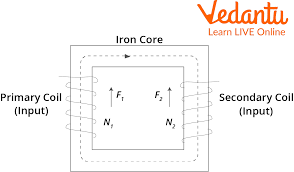




Everything You Need to Know About Transformers: Types, Working, and Construction
A transformer is a key device in electrical engineering used to step up or step down the voltage in alternating current (AC) circuits. Transformers are essential in power transmission systems, converting high-voltage electricity for long-distance transmission and then stepping it down for safe use in homes and businesses. By adjusting voltage levels, transformers enable efficient energy distribution while maintaining the balance between the electricity generated at high voltages and the lower voltages consumed by users.
What is a Transformer?
Transformer Definition: A transformer is an electrical device used to transfer electrical energy between two or more circuits through electromagnetic induction. It typically increases (steps up) or decreases (steps down) the voltage, without affecting the frequency of the current. Transformers operate on Faraday’s Law of Electromagnetic Induction and are commonly found in power distribution systems, where they help to distribute electricity efficiently across regions.

Key Functions of a Transformer
Voltage Conversion: Transformers modify the voltage level in the circuit.
Energy Transfer: They transfer electrical power via mutual induction between the primary and secondary windings.
Electromagnetic Induction: Transformers rely on the principle of electromagnetic induction to function efficiently.
Types of Transformers
Transformers are classified based on several factors, including their voltage level, core material, winding arrangement, and installation location.
Based on Voltage Levels
Step Up Transformer:
These transformers increase the voltage from the primary side to the secondary side. Typically used in power plants to convert the generated high voltage to a suitable level for transmission.

Step Down Transformer:
These transformers decrease the voltage from the primary side to a lower level for safe use by consumers. Commonly used in residential areas.

Based on Core Medium
Air Core Transformer:
Uses air as the core material. Commonly used in applications where the flux is low, such as radio receivers.
Iron Core Transformer:
Uses iron as the core material. Iron core transformers are efficient at carrying magnetic flux and are typically used in power transmission systems.
Based on Winding Arrangement
Autotransformer:
A single winding is shared between the primary and secondary circuits, providing a more compact and cost-efficient solution.
Based on Location:
Power Transformer:
Used at power generation stations to handle high-voltage applications.
Distribution Transformer:
Used in local areas to distribute lower voltage electricity to homes and businesses.
Measurement Transformer:
Primarily used to measure parameters like voltage, current, and power in electrical systems.
Protection Transformer:
Ensures the protection of electrical circuits from surges and fluctuations, safeguarding the components from damage.
Construction and Working of Transformer
Construction of Transformer
Core: The core provides a low-resistance path for the magnetic flux and is usually made of laminated iron sheets to minimise energy loss.
Windings: These are coils of copper wire, wound around the transformer core. The primary winding receives the incoming AC, while the secondary winding provides the output. Windings are insulated to avoid short circuits.
Insulation Agents: Insulating materials such as oil, tape, and paper are used to prevent electrical short circuits and to maintain the integrity of the transformer over time.
Working Principle of Transformer
Transformers work based on the principle of electromagnetic induction. Here’s how the basic operation works:

Primary Coil: When alternating current (AC) flows through the primary coil, it generates a varying magnetic field around the coil.
Core: This magnetic field passes through the transformer’s core, which is made of a ferromagnetic material to enhance flux linkage.
Secondary Coil: The varying magnetic field induces an electromotive force (EMF) in the secondary coil, causing a current to flow through it. This process is known as mutual induction.
Ideal Transformer and EMF Equation
In an ideal transformer, there are no losses, meaning no magnetic leakage, ohmic resistance, or iron losses in the core. The EMF equation for transformers, which determines the induced voltage, is given by:
Where:
E1 and E2 are the induced EMF in the primary and secondary windings, respectively.
N1 and N2 represent the number of turns in the primary and secondary coils, respectively.
For a step up transformer, the ratio of
Transformer Efficiency
The efficiency of a transformer is calculated by comparing the output power to the input power:
High-efficiency transformers are essential for reducing energy loss during power transmission.
The formula for the efficiency of a transformer is given by
Applications of Transformers
Power Transmission: Transformers are used in long-distance power transmission, where high-voltage currents are stepped up to minimise energy loss.
Voltage Regulation: Transformers are used to ensure consistent voltage levels in electrical circuits.
Electrical Energy Distribution: Transformers are critical in providing electricity at usable voltage levels to homes and industries.
FAQs on Transformers
1. What is the working principle of a transformer?
The transformer operates on the principle of mutual induction, where a changing magnetic field in the primary coil induces a current in the secondary coil.
2. What are the three types of transformers based on voltage level?
The three types are step up transformers, step down transformers, and isolation transformers.
3. What are the main parts of a transformer?
The main parts of a transformer are the iron core, primary winding, and secondary winding.
4. Why do transformers burn or explode?
Transformers can burn or explode due to overloading, lightning strikes, corrosion, or power surges.
5. What is a step up transformer?
A step up transformer increases the voltage from the primary to the secondary coil, making it suitable for power transmission.
6. What is a step down transformer?
A step down transformer decreases the voltage from the primary to the secondary coil, ensuring the voltage is safe for use in homes and industries.
7. Define the turns ratio of a transformer.
The turns ratio is the ratio of the number of turns in the secondary coil to the number of turns in the primary coil. It determines whether a transformer is a step-up or step down transformer.
8. How does a transformer transfer energy between two circuits?
A transformer transfers electrical energy from one circuit to another through electromagnetic induction. The current in the primary winding generates a changing magnetic field, which induces a current in the secondary winding without any direct electrical connection.
9. What is the function of the core in a transformer?
The core of a transformer provides a path for the magnetic flux generated by the primary winding. It enhances the efficiency of the transformer by focusing and guiding the magnetic flux through the windings.
10. How does a transformer maintain voltage regulation?
A transformer maintains voltage regulation by adjusting the voltage output in response to changes in load. Transformers with on-load tap changers can adjust their turn ratio to regulate the output voltage.

















